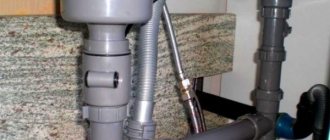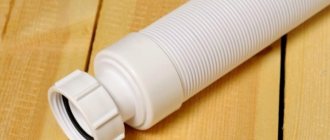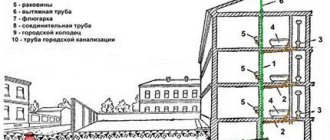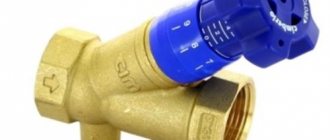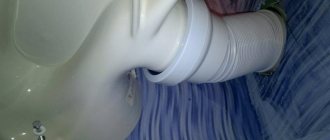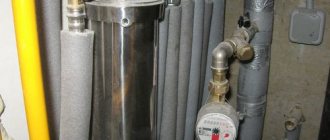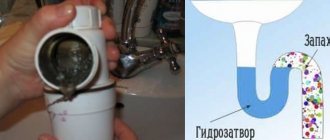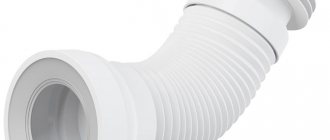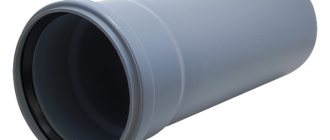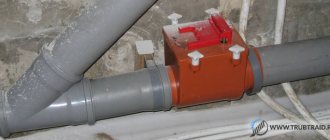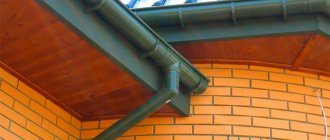When trying to equip kitchen spaces with fashionable sets and modern household appliances, you should not neglect a small device installed under the sink called a siphon. A sink siphon will allow you to avoid some unpleasant moments when using the drainage system. So, we’ll look at what this device is and how it works in this article.
Siphon installation process
A siphon is a pipe system that creates a water plug between the sink and the sewer. This design allows you to avoid unpleasant odors from the sewer network entering the room, and also collects debris from the sink in the sump, which prevents clogging of the drain system.
The role of a siphon can also be played by a pipe bent in a special way, which also creates a water plug. On sale, the siphon can come complete with a sink, but more often it has to be purchased separately.
Why do you need a siphon?
The kitchen sink (sink) is connected to the central or local sewerage system. Some homeowners and apartment owners connect the drain hole directly to the piping system that discharges sewage. For this, a corrugated pipe is usually used, which can be easily bent in the desired direction. However, if you do not create a water seal, “aroma” from the sewer system will enter the kitchen. The main purpose of a siphon is to block unpleasant odors from the sewer.
Manufacturers produce high-quality products that differ in:
- reliability;
- strength;
- durability exceeding the service life of the mixer;
- resistance to chemical compounds, high temperatures and mechanical stress;
- simple installation, which allows a person without experience to install a siphon in the kitchen;
- versatility of use.
additional information
The price of more complex drain structures is higher than that of a simple siphon, and their installation is also somewhat more complicated. Let's consider a couple of these options:
- Siphon with overflow . In this case, the flask has not two, but three holes. The procedure for connecting an additional outlet is similar to installing a pipe:
- We select a union nut and a cone-shaped sealing ring suitable for the overflow in diameter;
- We put a union nut on it;
- Pull the cone-shaped sealing ring with the blunt side up;
- We insert the assembled product into the siphon hole of a suitable diameter;
The process of connecting the overflow to the siphon is similar to installing a pipe
- Screw the reverse edge of the overflow to the hole on the back wall of the sink using a fastening bolt and a small screwdriver;
The overflow is screwed to the sink from the inside
- Siphon for double sink . Here, the main difference in the installation process is that the pipes are first connected to both sinks, and only then the rest of the drainage system is assembled.
Installing a siphon on a double sink begins with connecting the pipes
How does he work
The principle of operation of the siphon is based on its design feature. The lower part of the device, called a reservoir or sump, constantly contains water coming from the sink bowl. At this moment, high pressure arises in the drain - this leads to the displacement of the “old” liquid.
When the water supply stops, the pressure in the siphon equalizes. As a result, some of the liquid remains in the curved part. This water plug prevents unpleasant odors from entering the room from the sewer.
Water flows freely from the siphon and enters the sewer, and air cannot enter the room from the sewer, since the vertical pipe is located below the water level
The siphon plays another important role. Since it is installed after the kitchen sink, it is able to trap some debris. It accumulates in the sump and is easily removed by partial disassembly when removing the tank - the homeowner can carry out this procedure independently, without the involvement of a professional plumber. Preventing waste from directly entering the sewer system will prevent it from becoming clogged.
Useful tips
- It is better to choose systems with a smooth-walled pipe leading into the sewer; they are easier to clean.
- From the moment of dismantling the old siphon until the last stage of installation of the new one, it is advisable to plug the sewer pipe with a rag or plug of a suitable diameter.
- The surface of the sink around the drain hole must be thoroughly cleaned and degreased .
- All threaded connections are sealed, except for the thread of the flask lid - it will have to be unscrewed periodically; to prevent leaks, you can use tow.
- In flask-shaped models with a submerged tube you can adjust the height of the flask by immersing the pipe into it to different depths, but it should not touch the bottom; fixing it at the highest point is also undesirable.
- It is better to purchase a siphon with connecting dimensions such that the diameter of the sewer pipe corresponds to the diameter of the sewer socket.
- You need to buy a sink drain either simultaneously with it or after, taking into account its design and design features .
A modern kitchen sink drain is quite easy to install without the help of specialists. The main thing is to choose a model suitable for specific conditions , make sure there are no defects and follow the instructions.
There are a significant number of models on the modern market, and the installation of each of them has its own nuances, although the general principles are the same for all types and varieties of drains.
What do you think of this article?
General structure of the device
Different manufacturers produce sewer siphons; their design differs little from each other. The main details of the so-called kitchen sink elbow include:
- A decorative grate with small holes on the drain that prevents large waste from entering the sewer system. To install it, the kit includes a rubber gasket to seal the joint between the grate and the sink.
- Pipe for connecting the outlet and the filter grid. The part is secured with a corrosion-resistant metal bolt and nut.
- A siphon with a lower removable reservoir for cleaning when clogged - it eliminates the need to completely disassemble the elbow-shaped device.
The design of a siphon with the necessary components for its assembly.
The design of modern siphons (not only for a kitchen sink, but also a washbasin in a bathroom with or without an overflow) necessarily contains fixing rings with gaskets for connecting individual parts of the devices. The kit also includes a corrugated tube for connecting the outlet pipe of the siphon tank and the sewerage inlet.
Manufacturers create and produce different models, so their designs differ slightly in design and different number of parts.
Preparatory work
Preparation for installing a siphon comes down to dismantling the old one and cleaning the inner surface of the sewer pipe. When performing the last operation, you should not bother too much in the mud: the material (special rubber) of the cuff is designed to fit into a rough socket.
Difficulties may arise if the Soviet cast iron embedded in the pipe on cement is changed. In this case, you will have to work with a 50 g hammer and a chisel or chisel to tear out the old monster and remove the remaining cement from the pipe.
Caution: Remember that you are working with brittle cast iron. And make sure that cement fragments do not remain in the pipe, they will become a source of permanent blockages. It is convenient to remove debris from the pipe using tweezers or duckbill pliers.
Material of manufacture
Manufacturers produce plastic or metal drains. The metal used for construction is usually brass, bronze or stainless steel. Products in this design are excellent for open placement, as they will become one of the decorative elements of the kitchen space. However, they are much more expensive than plastic structures.
Stainless steel siphon
A common disadvantage is the accumulation of contaminants on the inner surface of the water seal. This leads to a gradual reduction in the cross-section of the device. If maintenance is not performed regularly, it will become clogged. However, dirt and grease adhere less to plastic than to metal.
Modern drainage structures made of metal are purchased if a set of expensive plumbing fixtures is installed and an exclusive interior is created. The installation of a metal siphon under a sink is often carried out by professionals, because the joints between its individual parts are sealed using rubber seals and fum tape.
In old houses you can see cast iron siphons - these are real rarities and are no longer produced.
Cast iron siphons can still be found in old houses
Mostly, plastic sink drain pipes are installed. They are practical designs that effectively fulfill their purpose. If necessary, they can always be replaced or cleaned. After all, they are inexpensive and are made with a smooth inner surface on which grease does not accumulate and other contaminants do not linger. Therefore, plugs rarely form in plastic structures. Such products are also lightweight.
Plastic is a material that is resistant to corrosion and has good temperature characteristics. Manufacturers use polyethylene or polypropylene for production. Only significant mechanical impacts can damage a high-quality device.
A siphon is also called a “sink sump”. A plastic drain is a construction kit because it can be disassembled and assembled in a certain sequence. If necessary, it is always possible to replace a single part or tighten one of the nuts if a leak occurs.
Bellows flexible liner
Structurally, such faucet hoses differ little from reinforced ones - except that they do not have an internal insert made of rubber or rubber. But if you look at the bellows liner more closely, it is easy to notice that the outer metal layer is not woven from wire, but is a solid corrugated tube. To the advantages that all flexible hoses have in general, bellows also have their own advantages:
- Great resistance to mechanical damage during compression and fracture.
- Crimping pressure up to 50 atm, although these hoses are recommended for workers 16 atm.
- Long trouble-free service life - about 25 years.
- The fittings are not pressed in, but are laser welded to the hoses, which makes the traditionally weak section of the connection to the mixer more reliable.
However, there was a fly in the ointment here too. In addition to their high cost, bellows tubes are also very noisy. However, this problem can be partially solved if you choose a hose with a larger diameter than the main pipeline. The bellows itself can be made of stainless steel, brass or even bronze. Naturally, products made from non-ferrous metal already belong to the premium class and are produced by only a few European luxury plumbing companies.
Dimensions
There is not much space under the sink, so the size of the structure is limited. In most cases, this siphon size is sufficient. For the device to operate efficiently, its bandwidth must also be taken into account. We should not forget about the distance between the outlet pipe from the siphon and the inlet of the sewer system. As a rule, the maximum height of the structure does not exceed 250 mm.
There are no exact standards here, except for the diameter of the drain pipe
Putting a siphon on a kitchen sink when the diameter of the drain and sewer pipe are the same size is not a problem. However, when there are differences in pipe diameters, it is necessary to think about their connection in advance. In this case, various cuffs and their connecting pipes are used. For example, a 50 mm internal double-socket tee will allow you to connect a 50*40 sink and a 50*25 washing machine with sealing collars.
Various adapter sleeves allow you to hermetically connect the necessary devices to the main sewer system
How to choose and buy a siphon for a kitchen sink: prices
You can see prices for some models of sink siphons in the table below:
| Photo | Models | Peculiarities | Average price, rub. |
| Siphon GEBERIT 150.520.21.1 | Material metal. Diameter 52 mm. | 2199 | |
| Siphon MARMORIN EN000008141 | High quality plastic. | 1500 | |
| VIEGA 103927 | Plastic case. | 239 | |
| Sink siphon Material Nicoll C292 | Polypropylene body. TRE gaskets. | 290 | |
| Siphon Wirquin | Material plastic. Water seal 50 mm. | 310 |
Review by Hamson, St. Petersburg: Siphon for kitchen sink Equation - It’s hard in the country without a siphon.
Advantages: price, simplicity and reliability
Disadvantages: none found yet
Most of my friends, especially women, believe that the main function of a siphon installed in a drainage system is to prevent it from clogging with oversized waste...
More details on Otzovik: https://otzovik.com/review_4961989.html
Review by Maua, Kramatorsk: Siphon Orio A-4007 with overflow – Wash the dishes? And with pleasure!
Advantages: functional removable mesh drain; overflow system; volumetric siphon bowl
Disadvantages: the kit does not include a flexible tube connecting the siphon to the sewer
My unexpected happiness began with the purchase of a new kitchen sink. The sink met all the requirements; it was wide, right-handed, with a deep bowl for washing dishes, but the drain hole was of non-standard large sizes. For this wide hole it was necessary to select a siphon with a similar hole. My husband picked it up, for which I will now be grateful to him forever, since washing dishes is now a real pleasure for me. The comparison, of course, is not very good, but still you have to wash dishes every day, so extra comfort in this matter will not hurt at all...
More details on Otzovik: https://otzovik.com/review_2656643.html
Common types
Manufacturers produce several types of sink siphons. They are selected depending on the characteristics of the installation site.
Some types of siphons: bottle with a tube, bottle with partitions, tubular
Corrugated drain
The corrugated tube is convenient to use when the sink drain hole has a non-standard location. This device is also used if you plan to install additional equipment or any necessary items under the sink. When connecting it to the sink, you need to pay attention to the amount of water in the curved place. It should be enough to create a reliable water lock, which guarantees reliable protection against the penetration of odors from the sewer.
A drain in the form of a corrugated tube is not an ideal design, because dirt quickly accumulates on the ribs of the product.
Structurally, the corrugated siphon consists of the following elements:
- pipe with grille and union nut;
- corrugated tube
Additionally, pipe fastening may be required.
Drain with corrugated pipe
The corrugated drain is installed in a matter of minutes. First, we attach the outlet pipe with the grate to the sink. Fixation is carried out using the gasket and screw included in the kit. Then the corrugation is inserted into the pipe at one end and secured with a nut, and the other side is inserted into the sewer pipe. If cleaning is necessary, the corrugated hose is disconnected from the pipe and the sewer. Then it is washed or replaced with a new one.
Bottle drain
Bottle siphons are most often installed. They are well suited when you need to drain dirty water and other waste from multiple sinks. In this case, the required number of special bends is installed.
The design of the bottle drain consists of the following elements:
- metal or plastic grille;
- intake pipe;
- bottle container;
- pipe for draining sewage into the sewer;
- a transition piece that allows you to connect the siphon to the sewer system.
The bottle drain is a completely rigid product. If necessary, the design is supplemented with corrugation for more convenient connection to the sewer. Cleaning the bottle drain is done by unscrewing the bottom part of the bottle-shaped container and removing accumulated dirt.
Pipe drain
This type of siphon is installed not only on sinks, but also on bathrooms. It has a completely rigid structure - outwardly similar to the letters S and U.
Simple pipe (straight-through) siphon
Since many modern kitchens have dishwashers, the pipe siphon may have an additional outlet.
Pipe siphon for sink McAlpine (UK) with outlet for household appliances, 40 mm (MRSK6). The MRSK4A model is equipped with an angular outlet. When choosing, be guided by the specified sizes
There are models of tubular siphons with a break in the stream flow. Such siphons are not attached to the sink - after installation there is a difference between the siphon and the sink. It is necessary to prevent germs from the sewer from entering the sink. They are used in preschool institutions and catering establishments.
Flat drain
This is a small siphon under the sink, where size is critical. It is usually used when a “washing machine” or dishwasher is installed under the sink. There are models with a break in the jet flow.
The design is a regular knee, but it saves space
In addition to small dimensions, a distinctive feature of a flat drain is also its rigid design. Such siphons rarely become clogged. If there is a need to perform a complete cleaning, the grille is unscrewed, and then the entire structure is removed from the sink.
With overflow
When the sink has overflow protection, a siphon with overflow is installed under it. The design of the product includes an additional pipe, to which a small diameter tube is connected from the overflow hole in the upper part of the sink. This design prevents the sink from overflowing with water and reduces the risk of flooding the room and neighbors living on the floor below.
A siphon with overflow is installed not only for sinks, but also for sinks
There are also drains with one or two outlets at the neck. They are used when it is necessary to additionally connect a dishwasher or washing machine.
Please note how many components a pipe siphon with overflow has. If you are afraid of getting confused when installing it yourself, it is better to invite a professional plumber
Overflow models
A kitchen siphon with an overflow is only suitable for a sink that has a corresponding hole in the upper part. This design will allow you to avoid water overflowing over the edge if the main drain is clogged with waste, blocked by dishes, or if water collected in the sink rather than running water is used for some purpose.
The overflow pipe can be rigid, assembled from parts, or corrugated; before connecting, its height must be adjusted in accordance with the depth of the sink.
If the tube is prefabricated, the height is adjusted according to the principle of telescopic sliding and sliding of parts and clamps are used. The corrugated pipe simply stretches and bends in the right place.
A flat gasket must be used between the inlet of the overflow pipe and the back of the sink around the opening
Connecting the overflow starts from the top, the last stage is to insert the free end of the pipe into the corresponding socket of the outlet pipe and fix it with a nut and a sealing gasket.
Basic selection rules
To ensure effective drainage of used water in the kitchen, you need to choose the right siphon. To do this, consider the following recommendations:
- You need to purchase the kit immediately. In addition to the siphon, it must contain all the necessary components for connecting it to the sewer. If parts are purchased separately, there is a possibility that they will not be able to be assembled into a single structure.
- It is necessary to measure the free space under the sink in advance. If it is minimal, you should give preference to a short siphon.
- With closed installation, there is no need to purchase an expensive designer siphon. It is better to buy a less beautiful product of good quality, but at a lower price. After all, no one will see it, and it will not spoil the interior of the kitchen.
- If the sink siphon is open, it makes sense to buy a product with a decorative design.
Each device always comes with instructions - you need to study them carefully before installation. It is also necessary to pay attention to the absence of damage to the siphon, the quality of the threads, sealing elements and plugs.
Hoses for kitchen faucets - saving effort or money?
When choosing a liner for a kitchen faucet, you want it to be not only inexpensive and easy to install, but also quite reliable.
The space under the sink is not too spacious to regularly carry out repair work here. And how often you will have to look there with keys and tow depends on the correct installation of plumbing in the kitchen and the quality of its main elements. The most popular type of connection for faucets today are flexible hoses (reinforced and bellows). They are really convenient to work with, but do they meet the reliability requirements? Let's figure it out.
Installation nuances
To install a siphon on a sink, an experienced person needs to spend a few minutes. If you don’t succeed so quickly, it’s okay. First you need to prepare the tools and consumables. The maximum that may be needed:
- screwdriver;
- gas key;
- sealant.
As a rule, when installing plastic products, all you need is a flat-head screwdriver.
If it is necessary to change the siphon, the old product is first dismantled. This procedure begins with installing a basin or other container under the drain to prevent water from getting onto the floor. First, all parts of the plastic siphon are removed. Then the protective grille is removed by unscrewing the screw. If a metal drain is dismantled, you will have to use a gas wrench.
Finally, the inside of the drain hole in the sewer riser is cleaned of contaminants. You can use a rag or paper towel for this.
How to collect drain correctly
At the beginning of the process, you need to check that all parts are present. To do this, we study the attached instructions and lay out all the elements, for example, on a table.
A bottle drain is often installed. Its assembly is carried out in the following sequence:
- The individual parts of the flask are connected after installing a gasket of small thickness. The sealing element must be pressed well against the part from all sides.
- The nut is secured to the corrugation.
- A cone-shaped gasket is placed on the corrugated pipe. The sharp part of the sealing element is located closer to the edge.
- The corrugated tube is inserted into the outlet pipe of the flask and secured by tightening the nut.
- On the other part with the grille, a second nut and gasket are fixed.
- The two separate parts of the siphon are connected by tightening the nut.
At the end of the process, the drain is secured under the sink. If necessary, you can use silicone sealant to improve the tightness of all siphon joints. It is recommended not to use too much force when tightening the nuts.
The nuts are tightened by hand! Don't use keys!
Installing a new device
The assembled drain structure is fixed to the sink as follows:
- gaskets in the form of rings are placed under the grate and on the top of the siphon;
- the assembled drain element is pressed from below to the hole in the sink, and a grate is installed on top from the side of the bowl;
- the screw is tightened;
- a nut and an o-ring are put on the pipe;
- the siphon is inserted and the nut is tightened;
- a hose is screwed to the siphon;
- the second end of the hose is connected to the sewer.
If necessary, an adapter is additionally used if the parts at the junction have different diameters. At the end of the installation process, the functionality of the drain is checked by filling it with water and checking for leaks.
Precautionary measures
Fecal water and sludge are very toxic and chemically aggressive substances; Sewer gases are also explosive. The danger is compounded by the fact that toxic substances can enter the body through intact skin.
Mainline plumbers are well aware of this and do not neglect safety precautions. Domestic plumbers rarely have to deal with large masses of toxic substances or gas emissions from a pipe, but in each such case the consequences are severe precisely because of the neglect of safety precautions.
Apartment residents have nothing to fear: the water seal in the siphon elbow reliably locks the pipe outlet. But when replacing the siphon, its pipe will be open, and you will have to work with your hands in the immediate vicinity of the sludge deposits and clean it off. Therefore, stock up on latex gloves, a plastic apron and a petal respirator. If suddenly you experience that same 1 in 10,000 cases, it will do no harm.
Manufacturers
The choice here is simply huge, from cheap Chinese goods to expensive branded ones. The choice for each situation is individual and is based on the installation location of the device, what kind of work it will perform and financial capabilities.
Some manufacturers:
- Akvater is a Russian company, quite well known and has its own sales market.
- AlcaPLAST - products of this company, a compromise of price and quality.
- Hansgrohe is a brand from Germany, a leader in quality and design.
Sealant
When installing a siphon, you will need a plastic or semi-liquid sealant. The best in terms of properties and inexpensive is silicone. You just need to make sure that it doesn’t turn out to be acidic. The test for chemical neutrality is very simple: squeeze a little and smell. If it tastes like vinegar, it’s no good, it’s acidic. A sealant suitable for plumbing should either have no odor at all, or the odor should be weak and not pungent.
Occasionally, sealant based on natural rubber (“Germeplast”, etc.) is found on sale. It looks like grayish or yellowish sticky plasticine. Very expensive, but the quality is indicated only by the estimated service life: 70 years. If necessary, the connection can be depressurized and the sealant can be reused.
Corrugation under the sink
Author Akulina asked a question in the Construction and Repair
What is the name of that white plastic thing under the sink that connects the sink to the pipe? and got the best answer
Answer from Yotalin [guru] Siphon.. From 100 rubles flexible corrugation. It’s easy to change, but there’s so much crap accumulated there that I wouldn’t recommend you climb on your own. If you decide, don’t forget to first place a basin, about a liter of water in the siphon.
Selected varieties
In addition to the design features of the structure, siphons differ in type and method of application:
- If there is no space under the sink for a conventional drainage device or it needs to be installed under the bathtub, then you can use a flat siphon. It is easy to install, takes up little space, holds odors perfectly, but it has one drawback: if it becomes clogged, you will have to disassemble the entire structure.
- Due to the increase in the number of household appliances, sink siphons with two or even three separate side fittings began to be produced. Thanks to them, you can connect a washing machine and a dishwasher to one drain at the same time.
- Complex devices are made for kitchen sinks that combine two or more pipes for connection to sinks with several sections.
USEFUL INFORMATION: Advantages of a touch-sensitive water tap: choosing an electronic mixer
